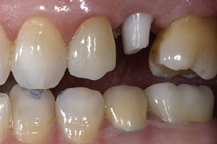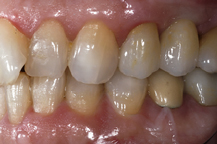
Abutment (dentistry)
Encyclopedia
In dentistry
, an abutment is a connecting element. This is used in the context of a fixed bridge (the "abutment teeth" referring to the teeth supporting the bridge), partial removable dentures (the "abutment teeth" referring to the teeth supporting the partial) and in implants (used to attach a crown, bridge, or removable denture to the dental implant fixture. The implant fixture is the screw-like component that is Osseointegrated
.

 These are usually called prosthetic implant abutments. These abutments can be made from a variety of materials, such as titanium
These are usually called prosthetic implant abutments. These abutments can be made from a variety of materials, such as titanium
, surgical stainless steel
and gold
. More modern abutments are now also made from zirconia, which is a white ceramic
, to better complement the aesthetics of a dental implant restoration. The two images to the right show a ceramic abutment and the ceramic crown bonded to it.Prosthetic abutments are connected to the dental implants via a screw. This screw needs to be tightened to a predetermined torque
, in order to avoid screw loosening during chewing, which can often create a counter-clockwise torque on the implant-abutment interface, encouraging the abutment screw to come loose. This can largely be prevented with proper screw design and torquing of the abutment.
The images to the right show how a ceramic abutment can enhance a ceramic crown by giving it a more life-like appearance. Ceramic abutments have to be used with care, however, since their compressive strength is nowhere near that of titanium, gold or other noble metals. Most clinicians feel more comfortable using a metal prosthetic abutment in the posterior molar
areas, due to the increased masticatory forces present in these areas.
An abutment is not necessarily parallel to the long axis of the implant. It is utilized when the implant is at a different inclination in relation to the proposed prosthesis.
Dentistry
Dentistry is the branch of medicine that is involved in the study, diagnosis, prevention, and treatment of diseases, disorders and conditions of the oral cavity, maxillofacial area and the adjacent and associated structures and their impact on the human body. Dentistry is widely considered...
, an abutment is a connecting element. This is used in the context of a fixed bridge (the "abutment teeth" referring to the teeth supporting the bridge), partial removable dentures (the "abutment teeth" referring to the teeth supporting the partial) and in implants (used to attach a crown, bridge, or removable denture to the dental implant fixture. The implant fixture is the screw-like component that is Osseointegrated
Osseointegration
Osseointegration derives from the Greek osteon, bone, and the Latin integrare, to make whole. The term refers to the direct structural and functional connection between living bone and the surface of a load-bearing artificial implant...
.
Bridge abutments
Bridge abutments are made such that the path of insertion of the teeth involved is nearly parallel with each other.Partial denture abutments
Partial denture abutments are unique in that they may incorporate elements such as rest seats, guide planes, and recontouring.Implant abutments


Titanium
Titanium is a chemical element with the symbol Ti and atomic number 22. It has a low density and is a strong, lustrous, corrosion-resistant transition metal with a silver color....
, surgical stainless steel
Surgical stainless steel
Surgical stainless steel is a specific type of stainless steel, used in medical applications, made out of several components: chromium, nickel and molybdenum....
and gold
Gold
Gold is a chemical element with the symbol Au and an atomic number of 79. Gold is a dense, soft, shiny, malleable and ductile metal. Pure gold has a bright yellow color and luster traditionally considered attractive, which it maintains without oxidizing in air or water. Chemically, gold is a...
. More modern abutments are now also made from zirconia, which is a white ceramic
Ceramic
A ceramic is an inorganic, nonmetallic solid prepared by the action of heat and subsequent cooling. Ceramic materials may have a crystalline or partly crystalline structure, or may be amorphous...
, to better complement the aesthetics of a dental implant restoration. The two images to the right show a ceramic abutment and the ceramic crown bonded to it.Prosthetic abutments are connected to the dental implants via a screw. This screw needs to be tightened to a predetermined torque
Torque
Torque, moment or moment of force , is the tendency of a force to rotate an object about an axis, fulcrum, or pivot. Just as a force is a push or a pull, a torque can be thought of as a twist....
, in order to avoid screw loosening during chewing, which can often create a counter-clockwise torque on the implant-abutment interface, encouraging the abutment screw to come loose. This can largely be prevented with proper screw design and torquing of the abutment.
The images to the right show how a ceramic abutment can enhance a ceramic crown by giving it a more life-like appearance. Ceramic abutments have to be used with care, however, since their compressive strength is nowhere near that of titanium, gold or other noble metals. Most clinicians feel more comfortable using a metal prosthetic abutment in the posterior molar
Molar (tooth)
Molars are the rearmost and most complicated kind of tooth in most mammals. In many mammals they grind food; hence the Latin name mola, "millstone"....
areas, due to the increased masticatory forces present in these areas.
An abutment is not necessarily parallel to the long axis of the implant. It is utilized when the implant is at a different inclination in relation to the proposed prosthesis.

